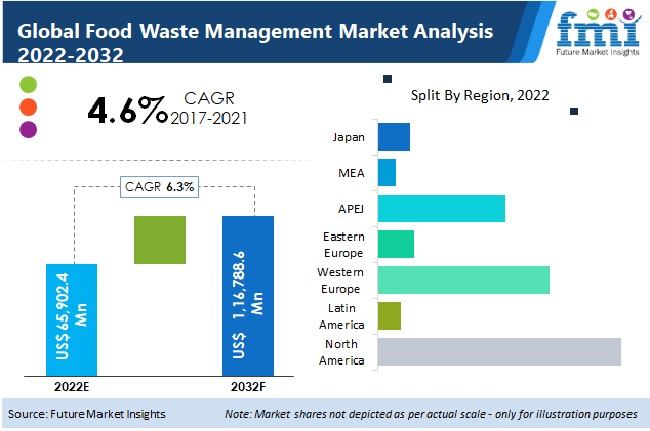The sales of food waste management market are estimated to be valued at US$ 62.6 Bn in 2022. As per Future Market Insights (FMI), the overall market value is expected to reach US$ 116.4 Bn by 2032, rising at a CAGR of 6.4% for 2022-32.
Request a Sample of this Report @ https://www.futuremarketinsights.com/reports/sample/rep-gb-2749

Food loss and spoilage have increased, prompting a reevaluation of resource utilization and sustainability. Governments and groups are working to reduce regional and local waste while also raising consumer awareness of the consequences of food waste. Furthermore, rising living costs, a scarcity of resources, and rising raw material costs are pressuring businesses and consumers to cut waste.
Ask An Analyst @ https://www.futuremarketinsights.com/ask-the-analyst/rep-gb-2749
Key Takeaways – Food Waste Management Market Study
- The food waste prevention segment is expected to rank relatively high on the attractiveness index in the global food waste management market. In 2022, the food prevention segment is anticipated to dominate the market.
- Food loss and wastage occurs at each node of the supply chain, from primary production to final end consumption.
- According to FMI survey, it is observed that around 85% to 90% of the overall food wasted in the developing economies is in the supply chain, including producers, processors, distributors, transportation & logistics, and retailer levels. In developing economies, food loss usually occurs in the earlier stages of the supply chain as a result of limited technology, inadequate infrastructural facilities, unfavorable climatic conditions, and insufficient processing and lack of marketing.
- In contrast, developed economies witness food losses and wastage to a substantial extent at the downstream stages of the supply chain.
- In 2019, food processing wastes is estimated to dominate the food waste management market by waste type.
- Rising preference for animal food production from food waste is expected gain traction in the food waste management market in the foreseeable future. Animal Feed, followed by fertilizers, are anticipated to remain the largest end-use segment globally during the forecast period.
- Increase in promotional activities and investments in renewable energy generation are leading to the growing market prospects for food waste management in North America. High demand for renewable energy and development in infrastructure encourages new players operating in recycling and processing food waste market.
Players in the food waste management market could strengthen their positions by introducing services in the rural areas where the concentration of food waste management companies is relatively low.
Technological Developments to Enhance Prospects for Food Waste Management Organizations
Increasing participation of small and mid-size enterprises in the global food waste management market provides opportunities for innovation in services offered by waste management companies. Through the development of innovative technologies such as shelf-life extension technology, companies operating in the food waste management market are able to expand their global footprint by leveraging the regulatory implications.
Buy Complete Report @ https://www.futuremarketinsights.com/checkout/2749
Know More About What the Report Covers
Future Market Insights, in its new offering, offers an unbiased analysis of the global food waste management market, presenting historical demand data (2012-2021) and forecast statistics for the period from 2022-2027. The study divulges compelling insights on the food waste management market based on the service (prevention, collection, transfer, recycling, and landfill), waste type (food production wastes, food processing wastes, distribution and supply chain wastes, retail wastes, and consumption wastes), and end-use (animal feed, fertilizer, renewable energy & biofuels, and others) across seven major regions.